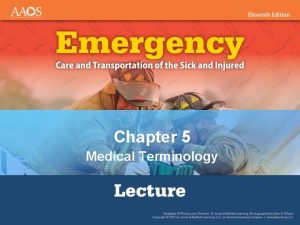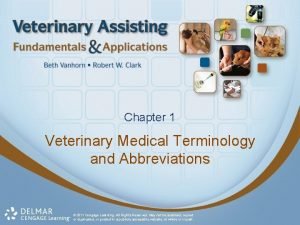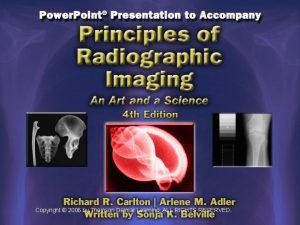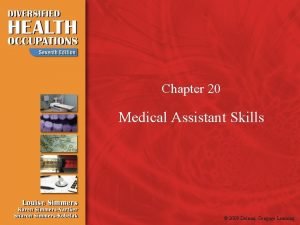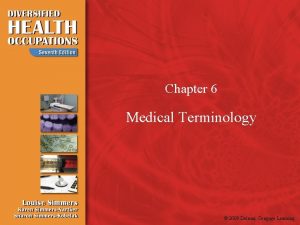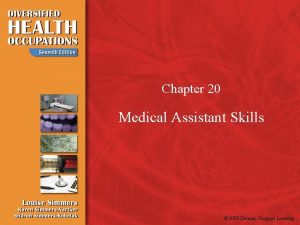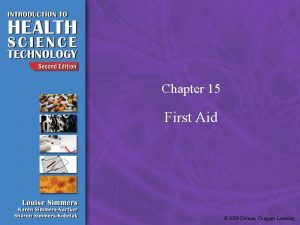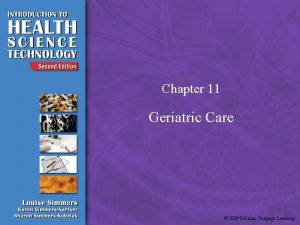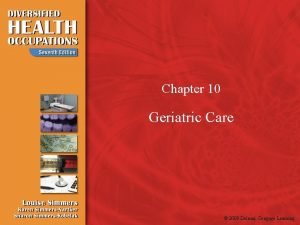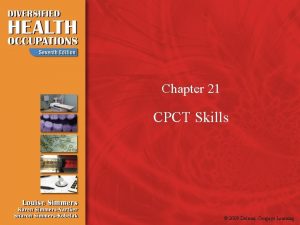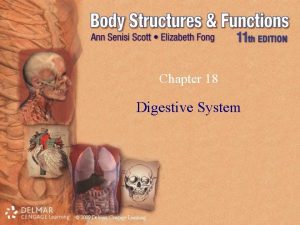Chapter 18 Medical Math 2009 Delmar Cengage Learning




























- Slides: 28

Chapter 18 Medical Math © 2009 Delmar, Cengage Learning

Introduction • Math skills are a requirement for working in a health care occupation • Calculations are needed for – Correct medical dosages – Recording height and weight – Intake and output measurement of fluids (continues) © 2009 Delmar, Cengage Learning

Introduction (continued) – Administrative tasks such as bookkeeping and billing – Tests performed in the lab – Mixing of cleaning fluids • Health care workers must make every effort to achieve 100% accuracy © 2009 Delmar, Cengage Learning

18: 1 Basic Calculations • It is necessary to be able to add, subtract, and divide whole numbers, decimals, fractions, and percentages • Understanding of equivalents when using decimals, fractions, and percentages • When taking professional exams for licensure or certification, calculators are sometimes not allowed © 2009 Delmar, Cengage Learning

Whole Numbers • Do not contain decimals or fractions • Addition—adding numbers together to find the total amount • Several uses in health care – Inventory records – Statistical information on patients • Example (continues) © 2009 Delmar, Cengage Learning

Whole Numbers (continued) • Subtraction—taking a number away from a number to find the difference • Several uses – Weight loss – Pulse deficit calculation • Example (continues) © 2009 Delmar, Cengage Learning

Whole Numbers (continued) • Multiplication—same as addition or multiplying to find the quantity • Several uses include – Payroll records (salary amount paid for number of hours worked) – Microscope power magnification • Example (continues) © 2009 Delmar, Cengage Learning

Whole Numbers (continued) • Division—finding how many times a number is contained in another number – Finding cost of one item – Determining amount of diet nutrients • Example © 2009 Delmar, Cengage Learning

Decimals • Decimals—are based on the number 10 • Represent the number of tenths, hundredths, thousandths, and so on • Are added, subtracted, multiplied, and divided the same as whole numbers • Always check the placement of the decimal point to avoid mistakes • Examples (See Table 18 -1 in text) © 2009 Delmar, Cengage Learning

Fractions • Fraction—a quantity less than a whole number expressed as a decimal • Has a numerator (top number) and a denominator (bottom number) • Some fractions need to be reduced to their lowest term • See Table 18 -2 in text • Examples (continues) © 2009 Delmar, Cengage Learning

Fractions (continued) • Improper fractions—numerators are larger than denominators • Converting fractions is used for addition and subtraction • Multiplying fractions • Dividing fractions—needs to be inverted (reciprocal) and then multiplied • Examples © 2009 Delmar, Cengage Learning

Percentages • Percentages—whole or proportion of a whole (100%) • See Figure 18 -4 in text • Advantage is to convert the percentage to a decimal before adding, subtracting, multiplying, and dividing • Examples © 2009 Delmar, Cengage Learning

Ratios • Shows relationship between like values or numbers • Health care workers use ratios for strengths of solutions • 50 percent strength solution is 1: 2 ratio © 2009 Delmar, Cengage Learning

Converting Decimals, Fractions, Percentages, and Ratios • Decimals, fractions, and percentages represent parts of a whole • There are specific methods of conversion from one to another • See Table 18 -3 in text © 2009 Delmar, Cengage Learning

Rounding Numbers • This requires changing them to the nearest ten, hundred, thousand, and so on • Depends on degree of accuracy • Refer to Table 18 -4 in text • Examples © 2009 Delmar, Cengage Learning

Solving Problems with Proportions • Proportion—equality between two ratios (“two is to six as three is to nine”) • For converting from one unit to another when three in the proportion are identified • Examples © 2009 Delmar, Cengage Learning

18: 2 Estimating • Estimating—a reasonable approximate calculation of the answer • Errors can occur with numbers in wrong order or decimal points misplaced • Practice and thought is needed when learning to estimate answers and detecting incorrect answers • Examples © 2009 Delmar, Cengage Learning

18: 3 Roman Numerals • Numbers used today are known as Arabic numerals (1, 2, 3, and so on) • In the health care field Roman numerals are used for specific reasons • Examples • See Table 18 -5 in text © 2009 Delmar, Cengage Learning

18: 4 Angles • Used in health care for – Injection of medications – Description of joint movements – Indication of bed positions (continues) © 2009 Delmar, Cengage Learning

Angles (continued) • Angles are made when two plane surfaces meet along a line • The distance between the plane and line of the angle is measured in degrees • See Figure 18 -6 in text • Examples © 2009 Delmar, Cengage Learning

18: 5 Systems of Measurement • Various systems of measurement used in health care • Terminology in each system – Distance (length) – Capacity (volume) – Mass (weight) • Each system has its own method of naming (nomenclature) © 2009 Delmar, Cengage Learning

Household System • Used in the United States • See Table 18 -6 in text • With basic equivalents known then unknown measurements can be found by using proportions • Examples © 2009 Delmar, Cengage Learning

Metric System • More accurate than the household system • Metric units – Distance/length: meter (m) – Capacity/volume: liter (l or L) – Mass/weight: gram (g or gm) • See Table 18 -7 in text • Metric system based on multiples of tens • Examples © 2009 Delmar, Cengage Learning

Apothecary System • Oldest and used less than the metric or household systems • Still used by some doctors • Necessary for health care workers to be able to convert within the system • See Table 18 -8 in text (continues) © 2009 Delmar, Cengage Learning

Apothecary System (continued) • Use of lowercase and uppercase Roman numerals sometimes used along with this system • Example © 2009 Delmar, Cengage Learning

Converting Systems of Measurement • Health care workers need to be aware of equal values between units • Not an exact science when converting • The answer is considered to be approximately the same • See Table 18 -9 in text • Examples © 2009 Delmar, Cengage Learning

18: 6 Temperature Conversion • Use of the Fahrenheit (F) thermometer scale in the United States • Centigrade (Celsius) or C is often used in health care • Conversion charts and formulas (using fractions or decimals) are available • See Tables 18 -10 and 18 -11 in text © 2009 Delmar, Cengage Learning

18: 7 Military Time • Traditional system of correct time uses A. M. and P. M. (12 hours) • Errors can occur if time is misread • Accuracy of time is critical in health care • Military time is based on a 24 -hour day • Avoids any confusion • See Table 18 -12 in text • Examples © 2009 Delmar, Cengage Learning
 Chapter 6:2 interpreting word parts
Chapter 6:2 interpreting word parts 2009 delmar cengage learning
2009 delmar cengage learning 2009 delmar cengage learning
2009 delmar cengage learning Measuring and recording apical pulse
Measuring and recording apical pulse Chapter 6 the skeletal system answer key
Chapter 6 the skeletal system answer key Chapter 13 medical math assignment sheet
Chapter 13 medical math assignment sheet Chapter 10 cultural diversity
Chapter 10 cultural diversity Delmar cengage learning instructor resources
Delmar cengage learning instructor resources Proximal medical term
Proximal medical term Cengage medical terminology chapter 1
Cengage medical terminology chapter 1 Thomson delmar learning
Thomson delmar learning Chapter 7 cengage
Chapter 7 cengage Color blindness medical term cengage
Color blindness medical term cengage Chapter 6:2 using medical abbreviations
Chapter 6:2 using medical abbreviations Chapter 5 the cardiovascular system labeling exercises
Chapter 5 the cardiovascular system labeling exercises Cengage learning heart diagram
Cengage learning heart diagram South-western cengage learning
South-western cengage learning Cengage learning heart diagram
Cengage learning heart diagram Cengage learning australia
Cengage learning australia Whille
Whille Cengage learning
Cengage learning Wadsworth cengage learning
Wadsworth cengage learning Cengage learning
Cengage learning Cengage learning plant cell
Cengage learning plant cell Cengage learning
Cengage learning Cengage learning
Cengage learning Brooks cole cengage learning
Brooks cole cengage learning 2014 cengage learning accounting answers
2014 cengage learning accounting answers Cengage chapter 7
Cengage chapter 7








